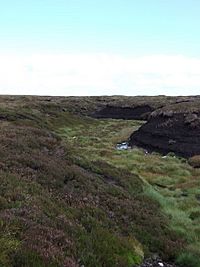Arkengarthdale Gunnerside and Reeth Moors facts for kids
| Site of Special Scientific Interest | |
 |
|
| Area of Search | North Yorkshire |
|---|---|
| Grid reference | , |
| Coordinates | 54°25′37″N 2°04′34″W / 54.427°N 2.076°W |
| Interest | Biological |
| Area | 7,634.72 ha (18,865.8 acres) |
| Notification | June 1998 |
| Location map | Natural England |
Arkengarthdale Gunnerside and Reeth Moors is a very large and special natural area in the Yorkshire Dales. It's known as a Site of Special Scientific Interest (SSSI) because of its unique habitats and the rare birds that live there. This amazing place covers over 7,600 hectares (about 18,800 acres) and is home to important blanket bogs and heather moorlands. It's a protected area where birds like the merlin and golden plover can live and raise their young safely.
Contents
What is Arkengarthdale Moors?
Arkengarthdale Gunnerside and Reeth Moors is a huge natural area in the Yorkshire Dales. It's so important that it's been given a special title: a Site of Special Scientific Interest (SSSI). This means it's one of the best places in the country for wildlife and natural features. The SSSI was officially recognized in June 1998. It's protected to make sure its special plants, animals, and landscapes stay healthy for a long time.
A Special Place for Nature
Being an SSSI means this area has special rules to protect it. These rules help keep the natural environment safe from harm. The main reasons this area is an SSSI are its unique types of land, like blanket bogs and heather moorlands. It's also important for the rare birds that breed here.
Amazing Habitats: Bogs and Moorlands
The Arkengarthdale Moors are home to two very important types of natural habitats: blanket bogs and heather moorlands. These habitats are crucial for many different plants and animals. They also play a big role in our environment, like storing carbon.
What is a Blanket Bog?
A blanket bog is a type of bog (a wet, spongy area of land) that covers large, flat or gently sloping areas. It's like a thick, wet blanket over the landscape. These bogs are made of deep layers of peat, which is partly decayed plant material. Peat forms very slowly over thousands of years because the wet, cool conditions stop plants from fully rotting away.
Blanket bogs are super important because they store huge amounts of carbon, helping to fight climate change. They also act like giant sponges, soaking up rainwater and slowly releasing it. This helps prevent floods and keeps rivers flowing during dry spells.
What is Heather Moorland?
Heather moorland is a type of open, uncultivated land covered mainly by heather plants. These areas are often found in hilly or mountainous regions. The heather plants create a tough, low-growing carpet that can handle strong winds and poor soil.
Heather moorlands are important for many types of wildlife, especially birds and insects. They provide food and shelter for animals. The purple flowers of heather in late summer make the moorlands look very beautiful.
Meet the Birds!
Arkengarthdale Moors is a vital breeding ground for several special bird species. These birds rely on the unique habitats of the bogs and moorlands to raise their young.
The Merlin
The merlin is the smallest type of falcon found in the UK. It's a fast and agile hunter, known for chasing smaller birds. Merlins often nest on the ground in heather or among rocks. They need large, open areas like these moorlands to find enough food and space to live.
The European Golden Plover
The golden plover is a beautiful wading bird with a striking golden-spotted back. They breed on open moorlands and blanket bogs. Their nests are usually just a scrape on the ground. Golden plovers are known for their haunting, whistling calls, which you might hear echoing across the moors.

